In 1982, Christy Burke, then a self-described IRA activist, was approached by Father Jim Smyth, a Jesuit priest, who lived in the Hardwicke Street flats. Smyth said, "I don't agree with the provos' policies, but all of the women in the flats respect you and we need your help. The place is riddled with drugs."
“So we met that evening in Hardwicke Street,” says Burke. “And we were sitting there and the mothers were saying, ‘Christy it’s terrible, the kids are on the stairs, they’re using heroin, they’re sticking it in their arm, we don’t know how to deal with it.’ The whole area was saturated… The State was doing nothing. There were no facilities… Nobody knew what to do….
“That day we had a meeting and the women said, ‘What do we call ourselves?’ and I said, ‘Why don’t we call ourselves, ‘Concerned Parents’ because that’s what ye are’. It was a room full of mammies and daddies with an IRA activist and a priest.”
What did they do? “We marched on four dealers that night. Three of them agreed to cease and help out and one didn’t and we put them out physically, [me] and the priest and the mothers and fathers. We took out their possessions, which wasn’t much and we told them to leave.”
From the early 1980s to the late 1990s, communities in certain parts of Dublin rose up to deal with a fatal problem they felt the State was ignoring.
To this day, many community activists in these areas were first politicised by the anti-drug movements of this period.
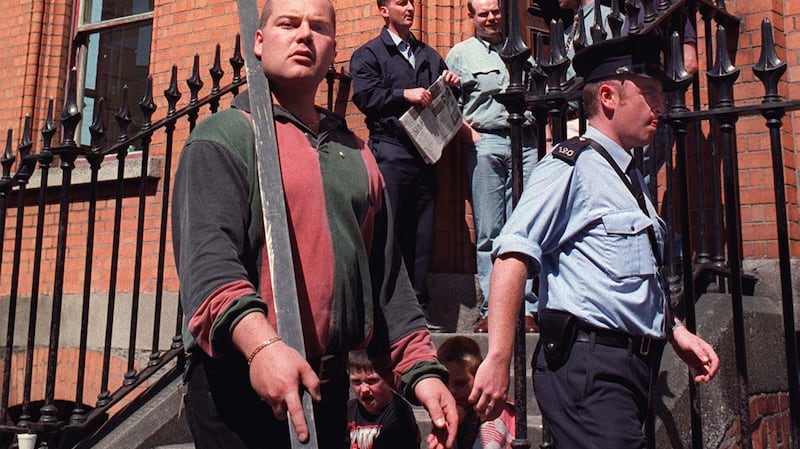
This article traces some of these groups and individuals and their legacy, specifically in the north inner city. There are many other stories to be told about the wider anti-drugs movement – which at times and in some places became associated with criminality and clashes with gardaí. But in Dublin 1 in particular, it was was considered to be cohesive, more centrally organised and, by many measures, successful.
Heroin was first brought to Dublin in bulk by Larry Dunne and his family in the late 1970s. By the early 1980s it was spreading fast, exacerbated by poverty and unemployment.
One anti-drugs activist explains the context. “If you look at this area in previous decades everyone worked on the docks,” he says. “My father worked on the docks. I worked in the docks. But [when] new technologies came in – containerisation – there were no jobs for the young people.”
The drug problem first manifested as a wave of petty crime. “Women in the inner city stopped carrying handbags,” says Christy Burke. It dawned on people slowly that this was a symptom of something more serious.
“I was project leader of the Neighbourhood Youth Project for young people at risk,” says Fergus McCabe, another veteran campaigner. “We were working with the kids who were the first heavy users of heroin. We ran a residential [programme] for four or five kids down in Mullingar in ’79 or ’80. Of those one ended up dying later in prison. Another died from Aids, again drugs-related. Another committed suicide.”
I carried out three corpses from my own constituency – a young woman dead in the armchair of the flat, needle in her arm, kids running around her.
Young people started to die in alarming numbers. "Me and Tony Gregory were carrying nearly two coffins a week," says Burke. "[The Minister for Health] Barry Desmond kept saying 'What epidemic?' and people were dying on the streets. I carried out three corpses from my own constituency – a young woman dead in the armchair of the flat, needle in her arm, kids running around her."
The Concerned Parents’ tactics were simple. People would meet, have a discussion and then they would march on the home of a known dealer to shame them into moving or ceasing their activity. Sometimes the community would barge in and remove all the belongings from an unrepentant dealer’s flat.
How does Burke feel now about such vigilantism now? “I don’t believe there was a family not touched by death and misery,” he says. “They had to do something. That’s what happens when the State ignores a community, you leave it open to vigilantism.”
They patrolled their neighbourhood. “We put up barricades because taxis would come in at night with addicts to buy from the flats,” says Burke. “We even contacted the taxi federation and said, ‘Tell your drivers not to come into Hardwick Street with addicts. It’s heroin-free now.’”
People from other areas began to follow their example. “They saw what they were doing [in the inner city],” says Cabra-based activist Betty Roche. “My first march would have been when my kids were in prams.”
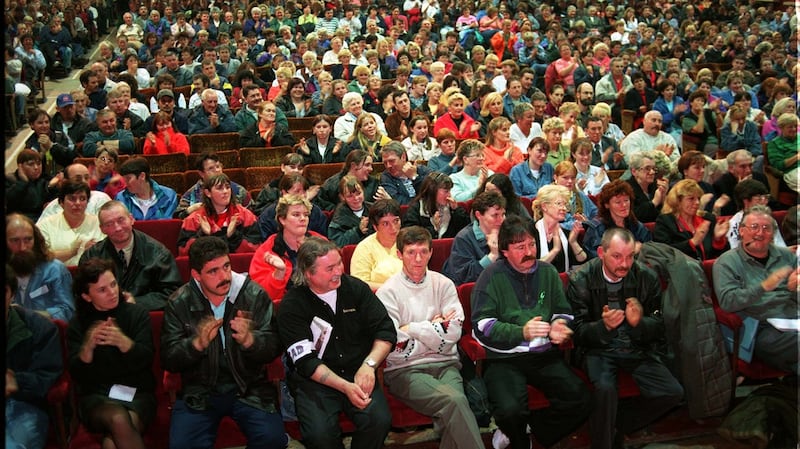
“People were obviously selling drugs,” says Fergus McCabe. “A lot of families were making money off it. They were flaunting it. Other families were devastated by it. And there was little knowledge of Aids and HIV, which was probably eventually the factor that made the State wake up and take real action.”
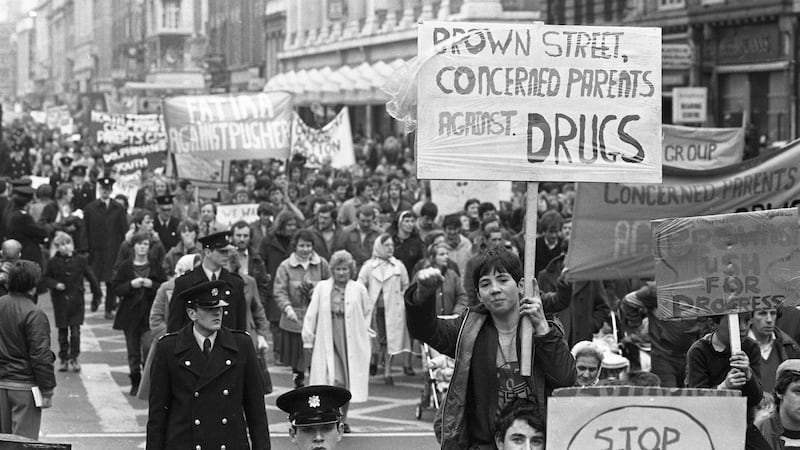
Burke recalls marching on Tony “King Scum” Felloni outside a billiards hall on O’Connell Street. They left a coffin outside Thomas “The Boxer” Mullen’s house on the Malahide Road.
Such actions took courage, says McCabe. He recalls a meeting where Larry Dunne turned up and Tony Gregory stood up and publicly challenged him. “He was very brave.”
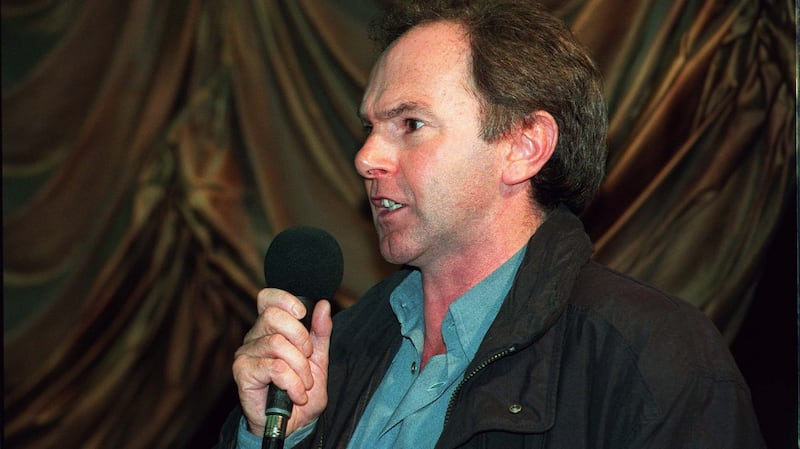
The movement was criticised in public, and many gardaí took a dim view of them. Some were determined to paint the movement as a front for the IRA, due to the involvement of Sinn Féin activists.
“Outside our meetings women were told by gardaí that they were associating with the IRA and Sinn Féin,” says Burke. “One woman said, ‘I couldn’t care less if I was associating with Ian Paisley and the UDA’.”
One January in the early 1980s, Burke remembers visiting 17 Garda stations where activists had been detained.
But not all gardaí had a negative view of the group. “The Concerned Parents Against Drugs in the north inner city was most beneficial and curtailed drugs to a great extent in terms of use and distribution of heroin in the area in the time it was in existence,” says Michael Finn, a retired garda who served with the drugs unit in Store Street from 1985 to 1993. “There was never any conflict between Concerned Parents and guards on the north side.”
Was it a “front” for the IRA? Christy Burke insists this wasn’t true, and that the Republican leadership had no interest in the Concerned Parents. But he says he specifically asked for IRA protection for anti-drugs activists when it became clear they were in danger from the drug gangs.
“They put out a statement,” he says. It said: “Any drug dealer who interferes with any community activists or Concerned Parents against Drugs will be severely dealt with.”
I ask former garda Michael Finn about threats from criminals to the Concerned Parents activists. He says: “When Concerned Parents got going there were some efforts made to intimidate [them].” As time went on, however, he says, the groups were too large and “it would be a very unwise man that would threaten the organisation as a whole”.
Fergus McCabe says the idea that the movement was dominated by Sinn Féin is inaccurate, at least when it comes to the north inner city. “There was a broader coalition [there] than in other areas,” he says. “Tony Gregory was very good at organising things. It was always about saying, ‘Why [are drugs] there in the first place?’ It was about… unemployment, poverty and poor housing.”
The activists acknowledge that the wider movement in Dublin was not above criticism. Fergus McCabe says the Concerned Parents marches were never about scape-goating addicts or vigilantism.
However, he says: “In some areas it imploded a bit. In Crumlin, there was messy stuff.” He’s referring to the kidnapping of Tommy Gaffney, a minor associate of Martin “The General” Cahill. Gaffney was kidnapped by members of the IRA in 1984 – an act widely perceived as being associated with the anti-drugs movement – and released a week later.

In parts of the city, Christy Burke says, there was criminal infiltration, and some people used the anti-drug groups to pursue petty grievances. “I was getting told by mothers [in those areas], ‘Christy, my son and daughters were stopped today and told if they didn’t have 500 quid… they’d be marched on.’ That was going on.”
As a consequence of this, Burke decided to focus more on his own locality. By the late 1980s, the marches had died away. According to Fergus McCabe, this was partly because there seemed to be some form of State response with the establishment of some drug services, but also, he says, simply because “of tiredness.”
By the early 1990s Dublin’s drugs problem had worsened again, and the marches started up again.

“The rave scene saw lot of the kids doing heroin when trying to come down off ecstasy,” says Sadie Grace, now chief executive of the Family Support Network. Some of those involved were themselves touched by addiction.
“I would have been one of those parents who was absolutely convinced my kids would never have touched drugs. They did their homework, they went to school, we brought them on holidays, we always worked, they always had what they wanted. I would have been of the stupid opinion that this was never going to happen at my door.”
Betty Roche was also shocked to find that the children she had taken to marches in their prams in the 1980s were now addicted to heroin themselves. She found herself confronting dealers on her own (“I was a little tartar,” she says) and gate-crashing raves to drag her children home.
Three of her five children developed addictions in their teens. “They told me they got the drugs coming from school in their uniforms.”
There was a lot of open drug dealing at that point. Joe Dowling points towards the square outside the Hands On Peer Education addiction service on Buckingham Street where he works. Back then it was the Joseph’s Mansions flat complex, “the biggest drug den around. The kids would come out on bikes and take orders and go back in and get the order.”
The first of the new wave of marches took place from Rutland Street school after six young people died in one week in the early 1990s. Joe Dowling chaired the meeting.
“People were very, very angry,” says Sadie Grace. “Icon [the Inner City Organisations Network] took a lead and said we need to be naming and shaming the people who are killing our kids.
“We would march on dealers who were seen to be flaunting their wealth. We’d chant ‘Pushers beware. Addicts we care. Pusher, pusher, pusher. Out out out.’ There would be a lot of shouting but never anything physical.”
“No-one was victimised wrongly,” says Betty Roche. “Everyone we marched on was doing something.”
“Once, [a march] went to the wrong door… and someone threw paint,” says McCabe. “Which we never did usually. The next day we had to remove it.
“We were always clear that we were not for [harassing] addicts. We were talking about shaming dealers and getting them to change. We didn’t want anyone to beat them up. Usually they knew we were coming and weren’t there.”
There were two big groups organising activity in the city at this point (with some crossover between them): Icon on the north side of the city, and Cocad, the Coalition of Communities against Drugs, on the south side.
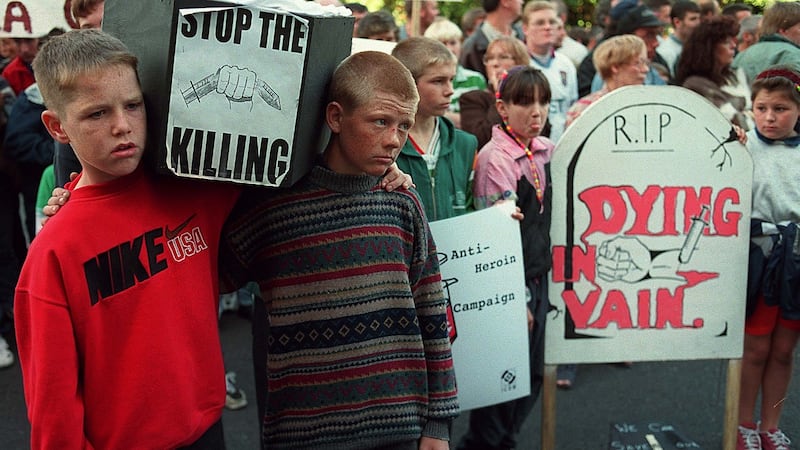
“Fergus McCabe was the chairman of Icon in the early days. Cocad, he says, were less inclined than Icon to work with State organisations. “[At Icon] we were more focused on policy change.”
The community put huts at Joseph’s Mansions and some other areas and manned the huts in an effort to deter both buyers and sellers. “People would bring food down to us and we had a fire,” says Joe Dowling. “Parents were burying four or five children out of the one household, so everyone at that stage was saying enough is enough.”
Were they frightened of the drug gangs? He laughs. “Well, we wore bullet proof vests,” he says.

Fergus McCabe insists that the huts were an important symbol of resistance more than anything else. The real work took place at the meetings.
"There'd be big public meetings in the church on Sean McDermott Street. There might be singing from Christy Moore and Frances Black. There'd be an hour of a process, which sometimes involved a prayer… There might be a report on dealing in Summerhill. Dr Joe Barry [from the Eastern Health Board] might give a talk about addiction. Then we might have had a copper or an addict would talk.
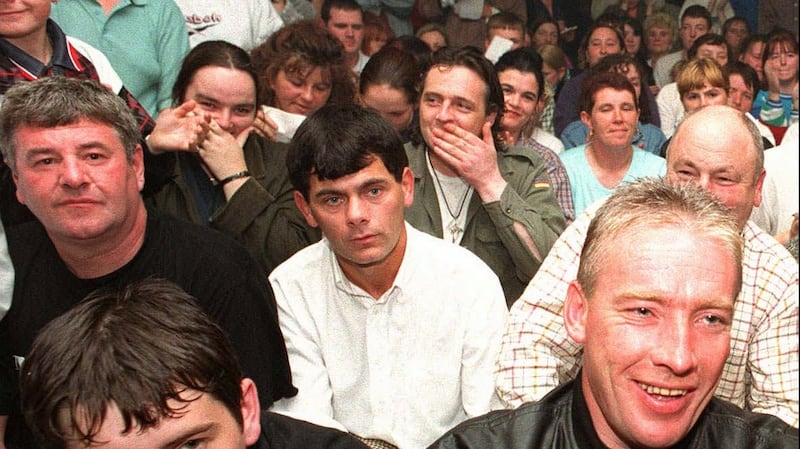
“Then you had people standing up going, ‘I want to march on that bollocks [so-and-so’s] house.’” He laughs. “And that’s the bit that would be covered [\by the media].”
People were struggling to do what they could for their loved ones in addiction. Joe Dowling recalls bringing young people out of the city to detox.
But there was nothing for them. I tried everything with them. Matthew killed himself. Karl drowned. Alison died last year... My only girl.
Betty Roche tells me about buying methadone on the street. “I even brought the boys to England,” she says. “But there was nothing for them. I tried everything with them. Matthew killed himself. Karl drowned. Alison died last year... My only girl. I won’t know until the inquest exactly what she died from. She left three children.”
The priorities of the movement slowly changed, says Sadie Grace. “It became very clear that some of the people being marched on were user-dealers, people who didn’t want to be dealing drugs.”
Activists knew that they themselves could become targets of their own movement, if there was addiction in their home. “It came home to us that it wasn’t going to be long before [a march] came knocking on any of our doors, because where were our kids going to get the money for their drug habits if not dealing?
“The street campaign took a different tack then, and there was a huge march over to government buildings [saying] we needed services for drug users.”
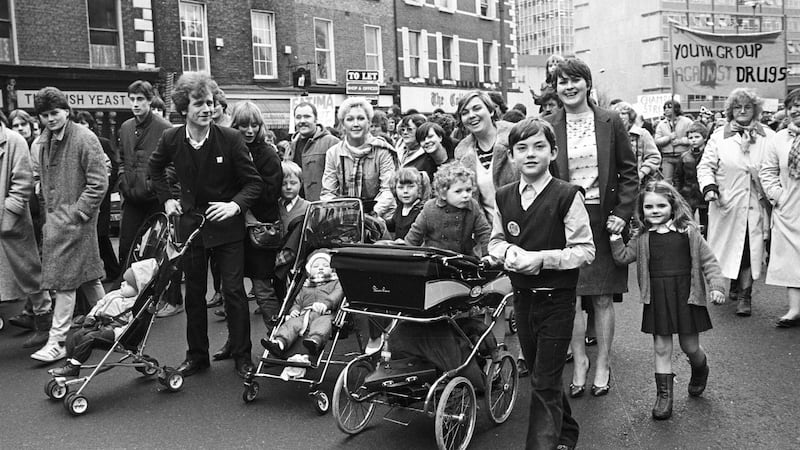
Dr Joe Barry, the Eastern Health Boards Aids/drugs coordinator, attended public meetings throughout this period trying to develop the State’s response to drug addiction with then controversial approaches such as methadone maintenance.
Barry was warned by some to be wary of whom he spoke to. “[They’d say] ‘You shouldn’t be talking to him because…’” he trails of. “I didn’t get involved in that level of detail. I took people as they were.
“When you hear the stories, you’d be amazed how resilient they were. People lost children to suicide. Mothers were doing their best for children… A lot of these people came from loving homes. They were trying to make their community better. Who wouldn’t do that?”
The marchers were still treated with suspicion by many politicians and journalists. In the mid-1990s Tony Gregory, Labour Party TD Joe Costello and others complained that activists were being harassed by gardaí.
Some of the suspicion may have been justified. There were certainly rogue actions that tainted the movement. Everyone was shaken in 1996, says Fergus McCabe, when Josie Dwyer, a heroin addict, was killed after an anti-drugs meeting in Dolphins Barn.
“That was horrific,” says Christy Burke. “No decent human being would stand over that . . . People didn’t turn out to marches as a result and you can understand that. You have men and women marching in the best interest of community and family; the last thing they want to hear about is a person in addiction being beaten to death. . . We wanted to help addicts.”
The anti-drugs movement was changing at this point. There had been progress on the policy front, partly in response to the shocking murder of the journalist Veronica Guerin in 1996.
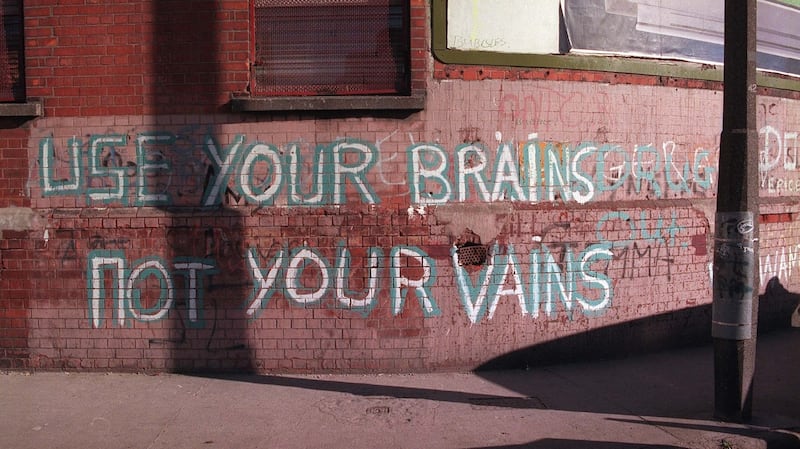
That year, the Rainbow coalition government published the Rabbitte report and created the Inter Agency Drugs Project, which ultimately led to community-based Drugs Task Forces.
Methadone clinics were established and ideas like the Criminal Asset Bureau, which had been suggested years before at community meetings, began to be implemented in earnest. Local communities began to feel listened to.
“The legacy [of the marches] was the creation of that partnership approach, which worked very well for the first five years,” says McCabe.
Most of the people I spoke to for this article now work in drugs services in some form or another. Sadie Grace helped found the Family Support Network and says the marches helped remove some of the stigma around addiction.
“People didn’t talk about [drug deaths at first]. Then we started to put a Christmas tree up at the square and people started gathering there to talk about their children who had died. We thought maybe we should look at putting a permanent structure there.”
Joe Dowling, who now works for Hope, was one of those involved with organising the memorial monument placed there in 2002. “There are no names on it,” he says. “Because every week we were burying someone, and you couldn’t have [sculptor] Leo Higgins coming out every week to add people.”
Fergus McCabe still works with the Citywide Drugs Crisis Campaign and is tentatively pleased with the “health-related” focus of the new National Drugs Strategy. “The marches and public meetings were really about saying, ‘We will not be f**king frightened by you guys,’ and it took a lot of brave people to do that.
“These were heavy guys. They killed Veronica Guerin… The State neglected its fundamental duty to areas like the north inner city [so] people had to get together themselves and stand up to it.”
The drug gangs still exist and, thanks to a violent feud, there’s arguably more fear of them now than in the past. Addiction is as big a problem as ever in the inner city, though nowadays users mix prescription pills, methadone, hash, alcohol, heroin and, increasingly, crack cocaine.
Just the other evening I was out with the soup run, and we came across a woman taking a needle out of her belly and passing it to a man… And I thought, 'Nothing has changed'
“Just the other evening I was out with the soup run,” says Christy Burke, “and we came across a woman taking a needle out of her belly and passing it to a man… And I thought, ‘Nothing has changed’.”
Dr Joe Barry believes that while the campaigners achieved a lot in the 1990s, properly tackling the drugs problem now involves eliminating “deprivation and poverty” and “that requires income redistribution on a bigger scale than any government would contemplate at the moment”.
The harm-reduction approach to drug addiction that Barry helped establish has certainly saved lives, though methadone maintenance is controversial among some veterans of the marches now. “The addicts call it ‘the handcuffs,’” says Betty Roche.
Roche’s own daughter was on methadone for 25 years when she died. “Addicts are lovely hearted people,” she says. “I can see their heart, their pain. I often sit up there in the park and look at them with their bottles and methadone and think, ‘Sure there’s nothing there for them. There’s only death’.
“Four or five months ago a girl stopped me and asked me would I not start the marches back up and I said, ‘I’ve done my stint.’… But actually, if they wanted to, I’d do what I could to help… Though I don’t have to do this anymore. My kids are dead.”











